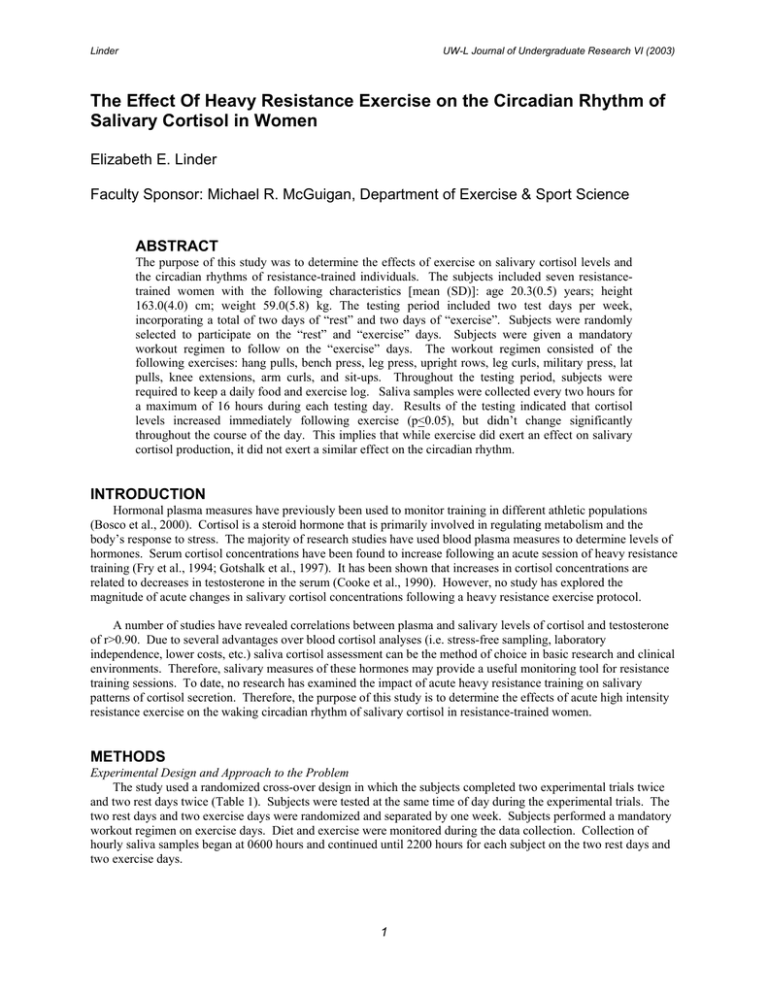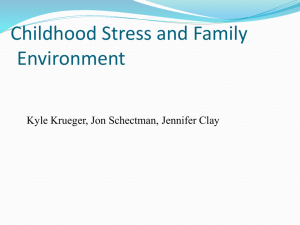The Effect Of Heavy Resistance Exercise on the Circadian Rhythm... Salivary Cortisol in Women Elizabeth E. Linder
advertisement

Linder UW-L Journal of Undergraduate Research VI (2003) The Effect Of Heavy Resistance Exercise on the Circadian Rhythm of Salivary Cortisol in Women Elizabeth E. Linder Faculty Sponsor: Michael R. McGuigan, Department of Exercise & Sport Science ABSTRACT The purpose of this study was to determine the effects of exercise on salivary cortisol levels and the circadian rhythms of resistance-trained individuals. The subjects included seven resistancetrained women with the following characteristics [mean (SD)]: age 20.3(0.5) years; height 163.0(4.0) cm; weight 59.0(5.8) kg. The testing period included two test days per week, incorporating a total of two days of “rest” and two days of “exercise”. Subjects were randomly selected to participate on the “rest” and “exercise” days. Subjects were given a mandatory workout regimen to follow on the “exercise” days. The workout regimen consisted of the following exercises: hang pulls, bench press, leg press, upright rows, leg curls, military press, lat pulls, knee extensions, arm curls, and sit-ups. Throughout the testing period, subjects were required to keep a daily food and exercise log. Saliva samples were collected every two hours for a maximum of 16 hours during each testing day. Results of the testing indicated that cortisol levels increased immediately following exercise (p<0.05), but didn’t change significantly throughout the course of the day. This implies that while exercise did exert an effect on salivary cortisol production, it did not exert a similar effect on the circadian rhythm. INTRODUCTION Hormonal plasma measures have previously been used to monitor training in different athletic populations (Bosco et al., 2000). Cortisol is a steroid hormone that is primarily involved in regulating metabolism and the body’s response to stress. The majority of research studies have used blood plasma measures to determine levels of hormones. Serum cortisol concentrations have been found to increase following an acute session of heavy resistance training (Fry et al., 1994; Gotshalk et al., 1997). It has been shown that increases in cortisol concentrations are related to decreases in testosterone in the serum (Cooke et al., 1990). However, no study has explored the magnitude of acute changes in salivary cortisol concentrations following a heavy resistance exercise protocol. A number of studies have revealed correlations between plasma and salivary levels of cortisol and testosterone of r>0.90. Due to several advantages over blood cortisol analyses (i.e. stress-free sampling, laboratory independence, lower costs, etc.) saliva cortisol assessment can be the method of choice in basic research and clinical environments. Therefore, salivary measures of these hormones may provide a useful monitoring tool for resistance training sessions. To date, no research has examined the impact of acute heavy resistance training on salivary patterns of cortisol secretion. Therefore, the purpose of this study is to determine the effects of acute high intensity resistance exercise on the waking circadian rhythm of salivary cortisol in resistance-trained women. METHODS Experimental Design and Approach to the Problem The study used a randomized cross-over design in which the subjects completed two experimental trials twice and two rest days twice (Table 1). Subjects were tested at the same time of day during the experimental trials. The two rest days and two exercise days were randomized and separated by one week. Subjects performed a mandatory workout regimen on exercise days. Diet and exercise were monitored during the data collection. Collection of hourly saliva samples began at 0600 hours and continued until 2200 hours for each subject on the two rest days and two exercise days. 1 Linder UW-L Journal of Undergraduate Research VI (2003) Table 1. Outline of Testing Schedule Week One: Week Two: Week Two: Week Three: Week Three: 1RM Testing Day One: Exercise Day Two: Rest Day One: Exercise Day Two: Rest Subjects The subjects included seven resistance-trained women with the following characteristics [mean (SD)]: age 20.3(0.5) years; height 163.0(4.0) cm; weight 59.0(5.8) kg. The subjects were currently involved in a resistance training program of at least two sessions per week. Subjects were non-smokers, and were not currently on any medication at the time of the study. Subjects were required to have a minimum of at least 12 months prior resistance training experience. Subjects were familiarized with the risk, requirements, and testing procedures of the study, and were required to complete both a medical history and exercise training questionnaire, and to sign a consent form prior to their acceptance and participation in the study. Subjects were instructed to refrain from oral contact of any kind (i.e. eating, drinking, brushing of the teeth, etc.) prior to the sample collection. Subjects were asked to maintain normal sleep patterns (i.e. approximately 8 hours/night), daily activity patterns, and dietary patterns throughout the duration of the study. Subjects were required to keep a daily dietary and exercise log on testing days. Strength Training Familiarization At least one week before the acute resistance exercise protocol, each subject was familiarized with all testing procedure and exercise testing protocols. Each subject’s ten repetition maximum (RM) strength was determined for each exercise, as well as ensuring correct lifting technique. The subject’s height, body mass, and percent body fat (using skinfolds) was determined before the testing session using standardized techniques (Jackson and Pollock, 1985). Acute Resistance Exercise Protocol The high intensity resistance exercise protocol was used for this study (Table 2). A similar protocol has been used previously and been shown to result in changes in endocrine function (Kraemer et al., 2001). The high intensity resistance exercise protocol consisted of 10 exercises performed for three sets of 10 repetitions per set with a load corresponding to the subjects’ 10RM and using two minutes rest between sets. A combination of free weight and exercise machines were used. Table 2. Heavy Resistance Exercise Protocol 1. 2. 3. 4. 5. 6. 7. 8. 9. 10. Hang Pulls 3 x 10RM Bench Press 3 x 10RM Leg Press 3 x 10RM Standing Row 3 x 10RM Leg Curl 3 x 10RM Military Press 3 x 10RM Lat Pulls 3 x 10RM Leg Extensions 3 x 10RM Arm Curls 3 x 10RM Sit-Ups 3 x 10RM Salivary Cortisol Saliva samples were collected during the acute resistance exercise sessions (without any stimulation, spitting directly into a glass tube). Samples were transferred to Eppendorf tubes and subsequently stored at -79°C until analysis. Subjects reported to the testing facility in Wittich Hall at 0600. Saliva sample one was collected after 15 minutes rest, after which the acute resistance exercise protocol began on the exercise days. Sample two was taken after the hang pull exercise was completed, and then immediately following the completion of the protocol on the exercise days. After the exercise protocol is completed, the subjects were allowed to leave and participate in their normal daily activities. Subsequent samples were taken every two hours for the entire day until 2200 hours by the 2 Linder UW-L Journal of Undergraduate Research VI (2003) researchers. Salivary cortisol concentrations were determined in duplicate by enzyme immunoassay using a diagnostic systems laboratories salivary cortisol enzyme immunoassay kit (DSL-10-671000ACTIVE, Webster, Texas). Intra-assay variance for salivary cortisol was 2.51%. Statistical Analysis Separate rest and exercise circadian rhythm data, as well as areas under the curve, were analyzed using a oneway analysis of variance with respected measures. A two-way analysis of variance with repeated measures was used to analyze combined rest and exercise circadian rhythm data. Fisher LSD post-hoc tests were used to determine pairwise differences if a significant F resulted. RESULTS The results of the hourly salivary sampling during the resting and exercise days are shown in Fig. 1. The results obtained in all days clearly showed a circadian rhythm with the highest concentrations obtained during the morning hours and lower concentrations observed later in the day. The results of the testing indicated that cortisol levels increased immediately following the resistance exercise (p<0.05), but didn’t change significantly throughout the course of the day. Figure. 1 Circadian rhythm of salivary cortisol (mean ± SD). A significant increase was observed post-exercise (0730) compared to baseline (P < 0.05) DISCUSSION The major finding of this study was that resistance training significantly increases the amount of cortisol present in saliva immediately following exercise, though it does not affect cortisol patterning of the circadian rhythm. The pattern of the cortisol response appears to be quite reproducible. This implies that while exercise did exert an effect on salivary cortisol production, it didn’t exert a similar effect on the circadian rhythm. Previous research by Kraemer et al. (2001) showed that resistance exercise did not affect the circadian pattern of salivary testosterone secretion over a 16-hour period in resistance trained men. However, there is no data available on the pattern of salivary cortisol secretion in resistance trained men. It appears that the introduction of stress (exercise) to the body activated a hormonal response to the stressor (an increase in cortisol). Once the body had reacted to the stress, the hormonal response was deactivated (cortisol levels returned to normal). This, in turn, implies that similar responses could be expected of a situation in which an external stressor is applied to the body. The study reinforces this theory, as well as emphasizes the function of cortisol as a regulator of the body’s response to stress. 3 Linder UW-L Journal of Undergraduate Research VI (2003) Previous research has suggested that gender and the menstrual cycle seem to have an impact of the cortisol profile (Kirschbaum and Hellhammer, 1994). A limitation of the present study is that is did not control for the phase of the menstrual cycle that the subjects were in. Also due to the small number of subjects tested, further research is required with more subjects to confirm these findings. CONCLUSIONS This study demonstrated that heavy resistance exercise had a significant effect on cortisol release immediately post exercise, but did not significantly affect the waking circadian rhythm in women. ACKNOWLEDGEMENTS Thank you to Dr. Michael R. McGuigan, Faculty Sponsor, Dr. Pat Dirocco, Head of the Exercise & Sport Science Department, Dr. Garth Tymeson, Interim Dean of the College of HPERTE, and the University of Wisconsin-La Crosse Undergraduate Research Grants Program for helping in making this study a reality. REFERENCES Bosco, C., R. Colli, R. Bonomi, S.P. von Duvillard, and A. Viru. 2000. Monitoring strength training: neuromuscular and hormonal profile. Medicine and Science in Sports and Exercise. 32: 202-208. Cooke R.R., J.E.A. McIntosh, and R.P. McIntosh. 1990. Is cortisol an important factor in the serum binding of testosterone? Proceedings of the Endocrine Society Aus 33: S53. Fry A.C., W.J. Kraemer, M.H. Stone, B.J. Warren, S.J. Fleck, J.T. Kearney, and S.E. Gordon. 1994. Endocrine responses to overreaching before and after 1 year of weightlifting. Canadian Journal of Applied Physiology. 19: 400-410. Gotshalk L.A., Loebel C.C., Nindl B.C., Putukian M., Sebastianelli W.J., Newton R.U., Häkkinen K., and W.J. Kraemer. 1997. Hormonal responses of multi-set versus single-set heavy-resistance exercise protocols. Canadian Journal of Applied Physiology. 22: 244-255. Jackson A.S., and M.L. Pollock. 1985. Practical assessment of body composition. Physician and Sports Medicine. 13: 76-90. Kirschbaum, C., and D.H. Hellhammer. 1994. Salivary cortisol in psychoneuroendocrine research: recent developments and applications. Psychoneuroendocrinology. 19: 313-333. Kraemer, W.J., C.C. Loebel, J.S. Volek, N.A. Ratamess, R.U. Newton, R.B. Wickham, L.A. Gotshalk, N.D. Duncan, S.A. Mazzetti, A.L. Gomez, M.R. Rubin, B.C. Nindl, and K. Hakkinen. 2001. The effect of heavy resistance exercise on the circadian rhythm of salivary testosterone in men. European Journal of Applied Physiology. 84:13-18. 4




